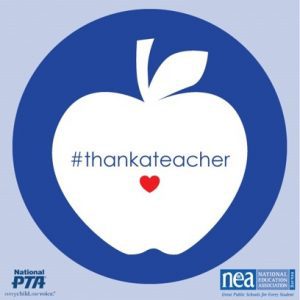 This week is National Teacher Appreciation Week, an annual observance to thank the teachers in our lives for their daily contributions to students. We’ve been celebrating the week since 1984, thanks to efforts by the National Parent Teacher Association, turning National Teacher Day, annually celebrated in March since 1953, to a week focused on these tireless educators.
This week is National Teacher Appreciation Week, an annual observance to thank the teachers in our lives for their daily contributions to students. We’ve been celebrating the week since 1984, thanks to efforts by the National Parent Teacher Association, turning National Teacher Day, annually celebrated in March since 1953, to a week focused on these tireless educators.
This year, amidst the coronavirus pandemic, our appreciation looks and feels differently than it has in the past. Saying “thank you” just doesn’t seem to be enough.
Teachers and school staff have had to make adjustments, in real time, to everything they’re doing, literally overnight. And teachers have met these challenges head on, from distance learning to working to ensure students’ basic needs are being met.
There have been countless examples of efforts to ensure students are fed and cared for. Some districts are organizing daily grab-and-go lunches, that include a breakfast for the next morning, along with printed learning packets. Community members have banded together to pick-up these nutritious lunches and deliver them to neighborhoods that need them most.
The fact is that “out of sight” isn’t out of mind when it comes to teachers. For many, their students are at the front of their minds, wondering if they are okay. Are they home safe and sound? Do they have food and a safe place to stay? Superintendent Joe Sanfelippo, of Fall Creek School District, advised teachers in a recent NPR story to not worry about assignments or quizzes. Instead, he said, ”we want you to call people. And I want you to ask them two questions: How are you doing? And do you need anything?” In the same article, Phoenix Union High School District Superintendent, Chad Gestson, agreed with that approach. “’There’s magic in phone calls,” he says. “Magic and personal touch.”’ Because the digital divide is so large in his area, Gestson’s district created the Every Student, Every Day initiative, pledging to call about 28,000 students daily. Check out this video, describing the effort in greater detail:
Other creative ways for teachers to connect with their students include teacher parades, where teachers and staff organize vehicles with handmade signs, balloon, and streamers, through neighborhoods, just to see their kids’ faces. And for the Class of 2020, whose year of celebrations and milestones was cancelled suddenly, high school teachers finding a way to celebrate their achievements through senior parades, as celebrated in this Cedar Rapids, Iowa school.
Online video conferencing platforms like Zoom and Google Hangouts overnight have become a new classroom, serving as ways for teachers and students to connect and to keep the learning flowing. However, not all students have access to devices and the internet, as noted in our digital divide research from fall of 2018, and most recently through a survey where more than 130,000 students shared their experiences. The divide is widening for students who don’t have access and the longer they go without access to learning resources, the further back these students may slide. This issue is top of mind for school officials.
With many parents and family members moving to support their children through learning at home overnight, the big job that teachers do is appreciated now more than ever. On social media, post upon post call out the need for better pay and more respect for teachers, as in this post from Shonda Rhimes:
Been homeschooling a 6-year old and 8-year old for one hour and 11 minutes. Teachers deserve to make a billion dollars a year. Or a week.
— shonda rhimes (@shondarhimes) March 16, 2020
She soon received many replies and direct messages, including this one:
Thank you, and we would be happy with a livable wage so we don’t have to work multiple jobs.
— Nicholas Ferroni (@NicholasFerroni) March 16, 2020
So, how can we honor teachers this week? There isn’t a right or wrong answer to this question. However, “thank you” just doesn’t seem to be enough — but it is a start. Take a moment and #ThankATeacher by posting on social media with your shoutout. And if you’re able, reach out directly to a teacher in your life who is making a difference every day.
